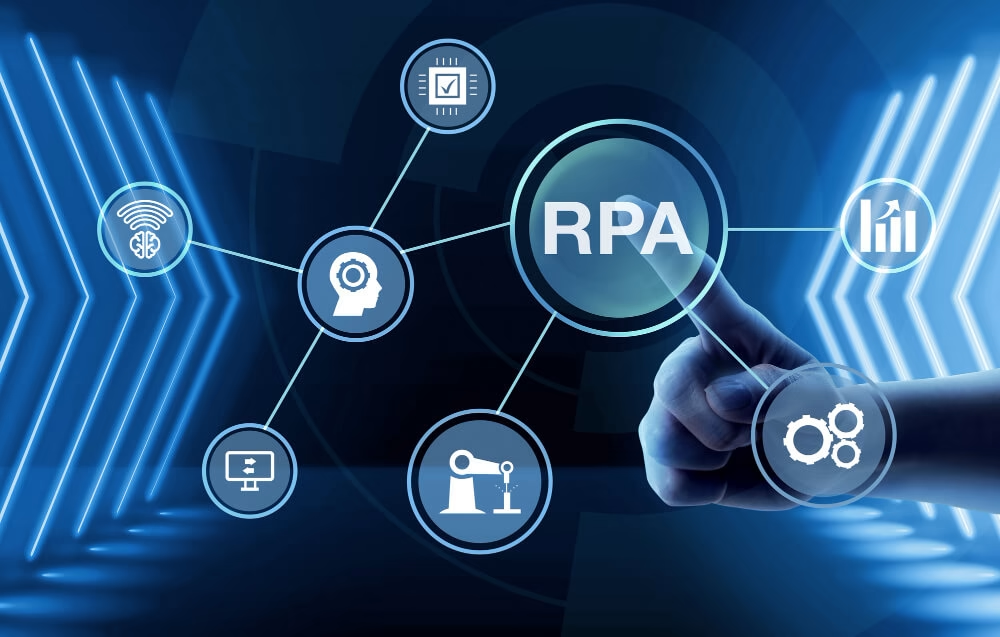Supply chain and logistics involve numerous mundane tasks like data entry, billing, collections, order processing, internal reporting, etc. Supply chain management deals with managing all these processes involved in the distribution of products to increase revenue by enhancing sales productivity, cutting down costs, and minimizing storage. AI and RPA are the technologies that can help managers achieve these goals.
Supply chain and logistics involve many processes that are manual and time-consuming. Some of the challenges that the supply chain and logistics personnel face on a daily basis are:
All these challenges can be eliminated with the help of intelligent bots and AI. The list of challenges that can be addressed with the use of RPA is exhaustive. RPA can be used to automate the processes across the supply chain operations like:

The order process is the core of the order fulfillment workflow. It deals with everything from when the order is placed and received by the customer. RPA can be used to automate the processing of the desired amount by the payment gateways and sending text and emailing to the customers regarding the confirmation of order placement.
Email automation: Bots can be deployed to make the communication of the shipment status clear to the customers, leading to a smooth experience and an increase in customer satisfaction.
Automate exporter’s information: A bot can be deployed to pull data from an excel file, feeds the data into the website, and extract available information to be shared with dedicated stakeholders.
Bill of Entry for CHA – Information extraction: Bots can be deployed to scan folders, read the Bill of Entry documents in standard PDF format, extract data of items, validate information like HSN, and generate the report in CSV format.
Distance Calculation for Bill of Entry: A bot can be deployed to fetch distance between two geographical points based on the pin code provided. This helps in identifying the exact distance between source and destination and helps organizations save cost on additional cost
Calculating freight cost: RPA helps with automatically fetching the details from the railway freight website and passing the information in CSV format to the respective teams.
Shipment tracking: RPA helps in finding shipment tracking information like location, status from logistics operator portals and inform respective teams
Invoice information extraction: Bots can be deployed to scan folders, read the Invoices, extract required data of the items, and generate the report in CSV format.
Invoice Validation, Reconciliation & Processing in the import lifecycle: RPA can be very helpful in reconciling the data based on customs declaration numbers. It also helps validate the invoices by preparing reports, highlighting the discrepancy in the following three buckets:
RPA systems can detect patterns from the past data on inventory and help reorder and maintain stock as per the market’s requirements. Bots can also be deployed to automate the checking of items in the warehouse, generate and validate delivery orders, send acknowledgment mails to respective parties, and fill details in ERP.
RPA can be used to automate customer service and relationship management by enhancing customer experience and satisfaction levels:
Enhanced speed of work processes: Personnel involved in the supply chain have many manual processes to carry on daily. Deploying a bot that can do the manual job of data entry, email communication, tracking the shipment, and extracting, sorting, and validating data would speed the work and increase the focus on critical decision-making and result-oriented tasks.
Decrease operational cost: Since the deployment of bots can increase the speed of operations, organizations can save the cost on human resources while decreasing the pressure on their employees at the same time, thus saving the cost on operations and improving the work efficiency of the personnel. RPA further helps prevent cost by:
Improved data for analysis: RPA helps in creating appropriate and accurate data. Organizations can deploy bots to go through large quantities of data to segregate valuable data. The accuracy of data extracted or created by a bot improves the quality of analysis, leading to better forecasts and minimized future risks.
Easy reconciliation of data: One can deploy a bot to compare data with the data present on different websites, PDFs, excels, etc., for generating qualitative and quantitative information that can be used to integrate processes for enhancing the overall performance of the entire supply chain system.
Efficient delivery: RPA can improve the efficiency of the delivery phase of the supply chain system. Bots can automatically assign delivery to the delivery partners based on the location of products and send information to the customers if the delivery delays, enhancing the customer experience with real-time order updates.
RPA, along with AI, has eased the life of organizations by performing all the repetitive and mundane tasks without human intervention. It’s not only economical but also efficient and structured. Supply chain managers should strive to implement RPA to keep track of logistics and update the inventory. Automation enablers like AutomationWhiz can help organizations build bots that assist their supply chain journeys and create a smooth supply chain experience.
